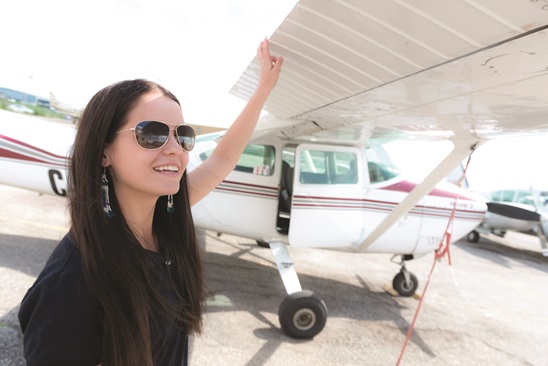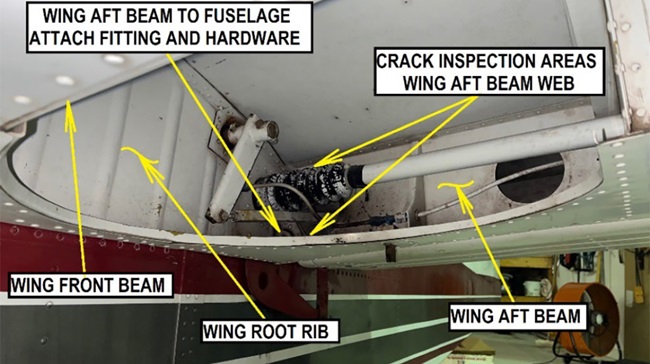 At a ground school session at Purdue University, student pilots are hunched over sectional charts and flight logs, preparing flight plans. Their instructor strolls among them, looking over their shoulders. Which of them, he wants to know, is ready to take the knowledge test? “Have you been taking those practice tests?” he asks one. “How’d you do?”
At a ground school session at Purdue University, student pilots are hunched over sectional charts and flight logs, preparing flight plans. Their instructor strolls among them, looking over their shoulders. Which of them, he wants to know, is ready to take the knowledge test? “Have you been taking those practice tests?” he asks one. “How’d you do?”
The student considers. “Ninety,” he offers.
The instructor nods. “Time to get that scheduled.”
This particular group is toughing out an intense, five-week accelerated program. They hope to become sport pilots—but first they have to endure a rigorous schedule, flying two or more times per day, spending weeks away from home. And they have to do all of this while coping with physical disabilities. The six are training in a unique partnership between Purdue and Able Flight, a nonprofit organization that challenges disabled persons by teaching them to fly (see "Challenges and Changing Lives," page 29). Three students are flying tandem two-seater Sky Arrow 600s equipped with hand controls for rudders and brakes. The other three students don’t require hand controls and are training in a side-by-side FK-9.
The flying bug. All but one of the students say they have wanted to fly since they were very young. Some, like Steve Scott, had even managed to log some time.
A few years ago Scott was lying in a hospital bed, reflecting on his life. He’d been injured in a car accident. “They just told me that my life is 20-percent shorter because I’m a paraplegic,” he recalls. “I needed to make my list. The first thing on my mind—I wonder if I could fly still.”
 Scott has no control of any muscle lower than his chest. He needs assistance to enter and exit the Sky Arrow; after he’s positioned in the front seat, he must balance himself on his elbows and shift his weight back and forth while manipulating the hand controls. He flies as early in the day as possible, and sometimes needs a break in the middle of the day before he can fly again. But there’s no hesitation, no suggestion that he won’t finish.
Scott has no control of any muscle lower than his chest. He needs assistance to enter and exit the Sky Arrow; after he’s positioned in the front seat, he must balance himself on his elbows and shift his weight back and forth while manipulating the hand controls. He flies as early in the day as possible, and sometimes needs a break in the middle of the day before he can fly again. But there’s no hesitation, no suggestion that he won’t finish.
“I want to be an advocate for this program on the West Coast,” Scott says. “My goal is to purchase an aircraft that is equipped and be able to introduce people” to flying.
A love affair. A sport pilot certificate is the goal at the end of the weeks-long program, but nobody wants to stop there. Matt Sponaugle of Elkins, West Virginia, says he’d like to get a private certificate and perhaps an instrument rating. “Wherever it takes me, I’m not sure yet,” he says. “This is an excellent starting point.”
Like Scott, Sponaugle has always been interested in airplanes. A skiing accident at age 13 put him in a wheelchair, but he recalls that about a year after the accident he took a sightseeing flight over the beaches of Nags Head in North Carolina. “They let me control the airplane for one turn and straight for awhile,” he says. “I fell in love with flying.”
Wesley Major, the lone student who hasn’t had a lifelong interest in flying, is nonetheless hooked. “I soloed Monday,” says Major, who recently graduated from the University of Delaware. “It was exhilarating.”
 A motorcycle accident at age 19 put Major in a wheelchair. Now 24, he credits Sean O’Donnell with encouraging him to apply for the program. O’Donnell got a sport pilot certificate in 2007 through Able Flight, and he has been Major’s friend and mentor, helping him through the transition after the accident. (O’Donnell also loaned his Sky Arrow to the Purdue program, and Major has been flying it.) Major has found the flight training “intimidating, because I had no prior aeronautical knowledge, so I thought I was behind the learning curve there.” Nonetheless, “they do an excellent job of force-feeding us the information,” he says.
A motorcycle accident at age 19 put Major in a wheelchair. Now 24, he credits Sean O’Donnell with encouraging him to apply for the program. O’Donnell got a sport pilot certificate in 2007 through Able Flight, and he has been Major’s friend and mentor, helping him through the transition after the accident. (O’Donnell also loaned his Sky Arrow to the Purdue program, and Major has been flying it.) Major has found the flight training “intimidating, because I had no prior aeronautical knowledge, so I thought I was behind the learning curve there.” Nonetheless, “they do an excellent job of force-feeding us the information,” he says.
First solo. For Tyrell Rhodes and Devin Radloff, learning to fly is part of a path to aviation that includes career aspirations. Rhodes graduated high school days before he came to Purdue. He’ll attend a community college in Illinois, and plans to eventually transfer to Purdue, where he’ll study aviation management and air traffic control.
Rhodes has cerebral palsy. The Purdue trip is the first time he’s ever been away from home. He soloed this week—one of the first two students to do so—and his mother made the four-hour drive from his home in Fairville Heights, Illinois, so that she could watch him fly by himself.
“I was really nervous in the beginning,” he says, “but once I took off, [I thought,] you can’t be nervous, you have to focus.”
Radloff, like Rhodes, is a recent high school graduate, and he also has cerebral palsy. He’ll train to become an airframe and powerplant technician at Fox Valley Technical College in Appleton, Wisconsin, near his home town of Janesville. He says he’d like to get a private pilot certificate and own his own airplane. He has lots of right seat time in a Beechcraft A36 Bonanza, thanks to a good friend and mentor named Larry Barton.
“I’m looking at soloing tomorrow,” Radloff says. The program has been “amazing,” he says. “Stressful, but fun.”
Learning experience. At Purdue University in West Lafayette, Indiana, flying is not simply a pastime or an undergraduate subject in a large catalogue. The university has its own airport, with its own control tower. Amelia Earhart, the first female to fly solo across the Atlantic, was on the faculty here, and she counseled women on careers in aviation. It seems appropriate that Purdue flight instructors are helping a new breed of student pilot gain their wings.
Able Flight has offered individual scholarship training for students since 2006. Able Flight and Purdue first tested the waters for an intensive training program in 2010, with the nonprofit securing aircraft and Purdue providing housing, food, and flight instructors recruited from undergraduate and graduate students. The partnership produced two sport pilots in 2010, and four in 2011.
“That first year was a learning experience,” says Bernard Wulle, associate professor of aviation technology. “Each time we do it, we find the things we didn’t get figured out before.”
 The 2012 session has six students, six flight instructors, and three aircraft, on loan from Hansen Air Group of Atlanta and Philly Sport Pilot of Wilmington, Delaware. Each student gets his own flight instructor, who learns how to adjust his teaching style to the student’s disability. That may be nothing more than ensuring a student gets a break so he has enough energy for a second flying session.
The 2012 session has six students, six flight instructors, and three aircraft, on loan from Hansen Air Group of Atlanta and Philly Sport Pilot of Wilmington, Delaware. Each student gets his own flight instructor, who learns how to adjust his teaching style to the student’s disability. That may be nothing more than ensuring a student gets a break so he has enough energy for a second flying session.
Or it may require something more creative. Flight instructor Justin Lowe is teamed with Jason Jernigan, who is deaf. Jernigan uses American Sign Language, but he does not read lips. Lowe does not sign.
On the ground, they used a UbiDuo—a face-to-face device that employs two small keyboards. Type in a sentence and it appears on the other user’s keyboard display. (The UbiDuo also made it possible for me to interview Jernigan for this article.) A signing translator assists Jernigan during ground school sessions.
For airwork in the FK-9, Jernigan taught Lowe some basic sign language, and they created some hand signals for steep turns and other maneuvers. Jernigan also had to cope with some dizziness in the cockpit caused by inner ear problems. Now 29, he has been deaf since he was 9 months old. The hearing loss is a result of a severe reaction to a diphtheria/pertussis/tetanus vaccination, he writes.
 Jernigan’s face brightens as he describes his first cross-country. “It was the best experience of my life,” he writes. He wants to become a private pilot, and then some—he’d like to earn a commercial certificate, and envisions one day operating a business in Florida where he would fly customers to scuba-diving destinations. This ties in nicely with his collegiate workload—Jernigan is studying underwater crime scene investigation at the University of Florida.
Jernigan’s face brightens as he describes his first cross-country. “It was the best experience of my life,” he writes. He wants to become a private pilot, and then some—he’d like to earn a commercial certificate, and envisions one day operating a business in Florida where he would fly customers to scuba-diving destinations. This ties in nicely with his collegiate workload—Jernigan is studying underwater crime scene investigation at the University of Florida.
“These students are so motivated and so passionate about flying,” Lowe says. Pointing to Jernigan, he says, “He texts me at 6 a.m. and asks, ‘Are we flying at 7?’ He’s ready to go… He never gets tired of it and he’s very passionate, which makes my job easier.”
Three years into the Purdue-Able Flight partnership, Wulle has no problems recruiting flight instructors. “When somebody is really invested in it, and they really want to do it, there’s a lot more boost in what you get out of it,” says Edwin Richardson, who is paired with Tyrell Rhodes.
Derek Stewart returned for a second year, bypassing an internship or a summer job. Like his student, Steve Scott, he’s considering ways in which he could become a permanent part of the Able Flight family. “It’s a challenge intellectually, emotionally, and physically,” he says of the program. “It’s an incredible adventure.”
Jill W. Tallman is technical editor of Flight Training magazine.



